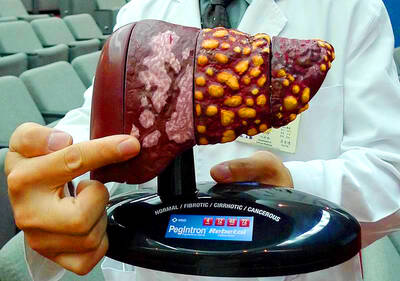Premier Liu Chao-shiuan (劉兆玄) yesterday offered an apology to patients with Hansen’s disease— also known as leprosy — for the “grievance” and “unequal treatment” they have suffered in the past, promising that his administration would take good care of their nursing and medical needs.
The apology came six months after the enactment of the Act of Human Rights Protection and Compensation for Hansen’s Disease Patients (漢生病病患人權保障及補償條例), which detailed measures the government must take to care for leprosy sufferers.
Making a public apology was one of the requirements of the Act as a way to restore the reputations of the patients, who had been labeled contagious and forced to live at the Losheng Sanatorium since Japanese colonial rule in the 1920s.

PHOTO: CNA
The segregation policy was continued by the Chinese Nationalist Party (KMT) government when it came to power and was not ended until the 1960s, despite the fact that a cure was found in the 1940s and it was proven that the disease was not infectious once treated.
Despite the lifting of the segregation policy, activists criticized the former Democratic Progressive Pary (DPP) government for failing to help the patients — many of whom have suffered deformities and skin disorders — return to the society and to end the social stigma and discrimination against the patients.
In Liu’s apology yesterday, he said that previous governments had not taken a positive and effective approach to end the discrimination against Hansen’s disease patients, which had led to an impairment of their dignity and human rights.
Former president Chen Shui-bian (陳水扁) in 2005 also offered an apology to leprosy patients, but his DPP administration supported tearing down the sanatorium to make way for a mass rapid transit system maintenance depot. Preservationists and residents who believe the sanatorium has important historic value for the nation’s public health and human rights history protested and began a prolonged campaign for its preservation. The government finally made a decision in 2007 to preserve 49 buildings on the campus, with 10 of them to be relocated.
Having been halted for years because of the controversy over Losheng, the construction of the maintenance depot finally restarted in December, after police forcibly removed preservationists who were still not happy about the new plans and residents who refused to leave.
Later yesterday, Department of Health Minister Yeh Ching-chuan (葉金川) also visited Losheng and offered an apology on behalf of the government to the residents over the isolation policy in the past — however, not all the residents reacted positively to the gesture.
While some Losheng residents welcomed Yeh’s apology and thanked him for renovating some of the buildings, others did not.
“I will not accept the government’s apology, because they did not apologize for what they did to me in December,” said Lan Tsai-yun (藍彩雲), a Losheng resident who was removed by the police from the Joan of Arc House. “I asked them to give me two more weeks to pack, but they refused. They cut the power and water while I was still inside, then they cut through the door with an electric saw and took me away by force. But look, Joan of Arc House still stands there today, a month after that incident — why couldn’t they give me two more weeks?”
Lee Tien-pei (李添培), another Losheng resident and chairman of the Losheng Self-Help Organization, said he had lost confidence in the government.
“Just saying ‘sorry’ doesn’t help — I’ll wait to see if they will fulfill their promises,” Lee said, referring to Yeh’s promise that no building would be damaged during the construction and that residents may move back to the preserved houses afterward.

The Executive Yuan yesterday approved a southwestern extension of the Sanying MRT Line from New Taipei to Bade District (八德) in Taoyuan, with a goal of starting construction by late 2026. The 4.03-kilometer extension, featuring three new stations, will run from the current terminus at Yingtao Fude Station (LB12) in New Taipei City to Dannan Station (LB14), where it will connect with Taoyuan’s Green Line, New Taipei City Metro Corp said in a statement. This extension will follow the completion of core Sanying Line, a 14.29-kilometer medium-capacity system linking Tucheng (土城), Sansia (三峽)

CARGO LOSS: About 50 containers at the stern of the ‘Ever Lunar’ cargo ship went overboard, prompting the temporary closure of the port and disrupting operations Evergreen Marine Corp, Taiwan’s largest container shipper, yesterday said that all crew members aboard the Ever Lunar (長月) were safe after dozens of containers fell overboard off the coast of Peru the previous day. The incident occurred at 9:40am on Friday as the Ever Lunar was anchored and waiting to enter the Port of Callao when it suddenly experienced severe rolling, Evergreen said in a statement. The rolling, which caused the containers to fall, might have been caused by factors including a tsunami triggered by an earthquake in Russia, poor winter sea conditions in South America or a sudden influx of waves,

The Ministry of Culture yesterday officially launched the “We TAIWAN” cultural program on Osaka’s Nakanoshima sandbank, with the program’s mascot receiving overwhelming popularity. The cultural program, which runs from Aug. 2 to 20, was designed to partner with and capitalize on the 2025 World Expo that is being held in Osaka, Japan, from April 13 to Oct. 13, the ministry said. On the first day of the cultural program, its mascot, a green creature named “a-We,” proved to be extremely popular, as its merch was immediately in high demand. Long lines formed yesterday for the opening

STAY VIGILANT: People should reduce the risk of chronic liver inflammation by avoiding excessive alcohol consumption, smoking and eating pickled foods, the physician said A doctor last week urged people to look for five key warning signs of acute liver failure after popular producer-turned-entertainer Shen Yu-lin (沈玉琳) was reportedly admitted to an intensive care unit for fulminant hepatitis. Fulminant hepatitis is the rapid and massive death of liver cells, impairing the organ’s detoxification, metabolic, protein synthesis and bile production functions, which if left untreated has a mortality rate as high as 80 percent, according to the Web site of Advancing Clinical Treatment of Liver Disease, an international organization focused on liver disease prevention and treatment. People with hepatitis B or C are at higher risk of